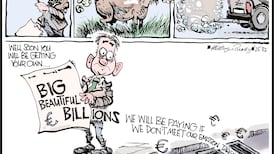BOOK OF THE DAY: The American Civil WarBy John Keegan, Hutchinson, 394pp, £25
ANOTHER BOOK on the American Civil War? There have been more than 50,000 written on the subject, surely there is nothing new to say. Well, there is nothing new in this book but that doesn’t render it redundant.
It is no mean achievement to get the war and its background into one volume. James McPherson did it in 1988 with his Pulitzer-prize winning Battle Cry of Freedom, but that is more than twice the size.
The author is defence editor of the Daily Telegraph and an eminent military historian. His expertise is evident on nearly every page; in essence the book is a military history of the war. However, his analysis and eye to detail on military tactics and logistics is formidable.
The author, like most others on the subject, takes the view that the South could never have won. Its leaders knew from the start that the North had the advantage in terms of manpower and industrial might.
But the South hoped, indeed expected, that Britain and France – huge buyers of the South’s cotton – would pressurise the North. They didn’t, and once the North effectively blockaded the southern ports the outcome was never really in doubt, if the North persisted. Lousy military leadership on the North’s side in the early stages made many wonder if it would.
Sir John – as he now is – notes that the war was almost entirely a rifle battle. Artillery played a subordinate role and cavalry played almost none at all. In fact, the war was one long continuous battle (almost 10,000 different battles) and the willingness of (most) soldiers to walk towards a hail of close order rifle fire resulted in huge casualties – more than America lost in both world wars combined.
The North suffered 110,000 battle deaths, the South lost 94,000. Twice as many, on both sides, died of disease. The North could fight on even with that level of loss, the South could not.
Women fought as well, possibly as many as 1,000 on each side. They evaded detection because, having cut their hair short, the cursory physical examination was not a problem. Soldiers didn’t undress to sleep, baths were rare, ill-fitting uniforms disguised the figure. Some women did it because they lost a husband or brother to the cause. Some did it for money.
Irish served in both armies, but mostly in that of the North where their strength ran to 150,000 out of a total of two million. Not all were willing combatants. When the North introduced conscription in 1863, most of the New Yorkers who rioted and looted in protest were Irish. They equated military service “with British oppression”.
As Keegan points out, the war was not specifically about slavery for the North. Lincoln did want to abolish slavery but much more he wanted to preserve the union. The South wanted to preserve state’s rights and the southern way of life – of which slavery was a major part. However, two years into the war Lincoln went ahead and emancipated all slaves.
But Lincoln’s promise of “life, liberty and the pursuit of happiness” did not apply equally. Keegan writes that Lincoln believed that blacks deserved the “same political rights” as whites. Lincoln shifted his position but, even after emancipation (never mind years earlier when he was seeking election), he said that blacks were inferior, that they should not inter-marry with whites and that they should not hold office.
The South continued, through trickery and violence, to deny civil rights to blacks.
If he had dodged the bullets in the Ford Theatre, would Lincoln, for whom preserving the union meant so much, have forced the South to get into line? His successors, up until Lyndon Johnson, did not.
Whether or not you have read much on the Civil War, this book is to be recommended.
Eoin McVey is a managing editor of The Irish Times








